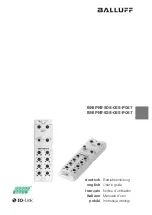
IOEM/REM Safey and Installation Guide
48
IOEM/REM Safey and Installation Guide
49
B. 4/20mA Analog output
Wire 4/20mA 5X00 instrument Analog output
4/20mA output device
CAUTION:
Observe correct polarity on analog output.
5.
Complete wiring to all IOEM I/Os that will be used in application.
6.
7.
Configure 5X00 system using AquaManager PC software as 4/20mA
output. Complete E-Aux system configuration information is provided
in the AquaManager Help system.
8.
Test E-Aux/IOEM 4/20mA signal output at PLC device.
Step 6 Wire Network
Multiple IOEM and REM, 5400 and 5500D-01, 5500D-02, 5500D-04 instruments
are networked using the RS485 network port. A node network consists of one master
and up to 31 slaves. The master can never be an IOEM or REM instrument. On a
network, the master is the point of access for the AquaManager PC software program.
RS485 network wiring can span distances up to 4000 feet (1220m). This maximum
distance (4000 ft) is for the total network distance, not the distance between net-
worked units (*see Notes below). RS485 ports are optically isolated for safety, to
reduce noise, and to help eliminate ground loops. No further isolation is required.
Network traffic refers to the constant communication between the master and all
slaves on the network. For example, if a slave 5200A pH system is configured to
have a slave REM relay 4 dose up when in control range, and the 5200A is in pH
control range. The 5200A slave delivers this information to the master and the master
relays this information to the REM over the RS485 network and relay 4 is energized.
Installation and Wiring
Notes:
-
*Use an RS485 Line Extender/Booster for distances over 4000’ (1220m).
Communication failures may occur without it. Mount the booster in an
area where it is protected from moisture.
-
Network traffic speed operates at ~ 230 KB and is not user selectable.
-
Remove network terminal strip from any networked slave that is not
powered. Network rewiring is required if a stub (**see next note) is
created when a slave is taken off the network. See valid network con-
figuration - figure 3.12, page 54
Note:
-
**A stub is created when the last wired network terminal strip is not
connected to a network slave - figure 3.9.
master
-represents wired network termination strip
-terminal strips located within master/slave image represent terminal strips that are physically
connected to device
-terminal strips that appear outside slave image represent terminal strips not connected to device
slave
slave
slave
slave
master
slave
slave
slave
slave
A stub is created when the last wired network terminal strip is not connected to a network slave.
Network wire stub
this is a stub
(wired terminal
strip is not physically
connected to last
physical slave on
network)
this is not a stub
(wired terminal
strip is physically
connected to last
physical slave on
network)
Figure 3.9
Directions to Wire Network
Network wiring consists of
two pairs of twisted pair cable plus a communications
common wire.
Category 5 ethernet cable is recommended. Network wires are ter-
minated at location
C
IOEM and
D
REM.
Installation and Wiring















































